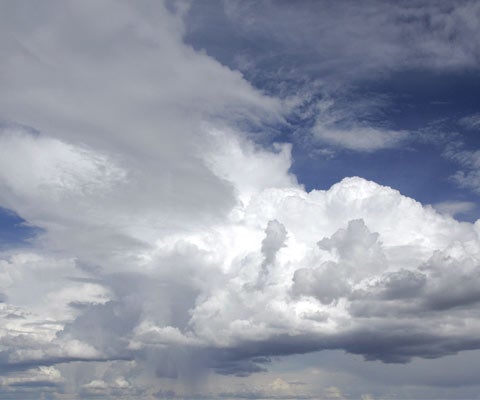Sara Chesiuk

We’ve all heard about the ozone layer. We know it’s a gas in the sky and that it protects the Earth from harmful UV rays. We’ve heard a little something about a hole, a little something about CFCs and a little something about depletion. But knowing “a little” isn’t enough, especially since the ozone layer is vital to our world’s well being. Not to worry, CWF’s got you covered with a crash course - Ozone Layer 101. Pencils ready?
What in the heck is the ozone layer anyway?
What exactly is ozone and how is the ozone layer created? First things first. Ozone (O3) is a colourless gas that is a chemical cousin of molecular oxygen (O2). Ozone is created when the sun’s light breaks apart one of the oxygen molecules, thereby producing two oxygen atoms. Next, these atoms combine with an oxygen molecule, ending up with an ozone molecule. These reactions occur continually wherever ultraviolet sunlight is present. As a result, the greatest ozone production occurs in the tropical stratosphere as it is closest to the sun. About 90 per cent of the atmospheric ozone is contained 15 to 35 kilometres above the Earth’s surface in the stratosphere. This spot is known as the ozone layer.
How does ozone depletion happen?
If ozone naturally produces itself, how on Earth – or should we say above Earth – is it depleting? Well, ozone is unstable and reacts continually with a wide variety of natural and human produced chemicals in the stratosphere. In each reaction an ozone molecule is lost.
Once released into the atmosphere, the remaining chemicals rise up to the ozone layer, where they are broken apart by ultraviolet rays. There are a couple of chemicals that have a rapacious appetite for ozone – chlorine and bromine. A single chlorine atom is capable of destroying thousands of molecules of ozone. Bromine is even more destructive.
The most common industrial chemicals containing chlorine and bromine are:
• CFCs (chlorofluorocarbons) which are used as coolants in air conditioners and refrigerators
• Halons, found in fire extinguishers
• Methyl bromide, which is a pesticide
• HCFCs (hydrogenated CFCs), used as a substitute for CFCs
Human emissions of these chemicals have increased considerably since the middle of the 20th century. The result has been global ozone depletion with the greatest losses occurring in polar regions.
What exactly is this “hole” above Antarctica?
In 1985 scientists with the British Antarctic Survey (one of the world's leading environmental research centres) discovered a large gap in the ozone layer above the Antarctic. The ozone depletion in the Antarctic has been dubbed the “ozone hole.” The area is now 25 million square kilometres – almost twice the area of the continent.
So, if the primary cause of ozone depletion is man-made chemicals, how is it that the Antarctic, with a population of zero, has the most damage? Formation of the hole requires copious amounts of reactive halogen gases, temperatures low enough to form polar stratospheric clouds, isolation of air from other stratospheric regions and sunlight. These four factors occur in the Antarctic.
Should I worry?
The smaller the ozone layer, the bigger the worries. Since the ozone layer shields us from harmful ultraviolet rays, our primary concern is the increase in UVB rays hitting the Earth. Every time one per cent of the ozone layer is depleted, two per cent more UVB rays reach the surface of the planet. This causes problems for both our well being and the overall well being of our ecosystem.
As for the impacts on humans, well you’ve probably experienced one after a long day at the beach. Increased UVB rays up your chances of experiencing sunburn. And though sunburns may be painful, they are not the most detrimental consequence. The major health concern is the increase in skin cancer. According to the National Cancer Institute, there were approximately 67,000 new cases of skin cancer in 1998 in Canada and according to a 2009 report put out by the Canadian Dermatology Association, melanoma is now the eighth most common cancer in Canada. Experts estimate about 90 per cent of melanomas are associated with severe UV exposure and sunburns over a lifetime. Over exposure to UV rays can also generate cataracts and suppress immune systems.
In terms of the environment, the ozone depletion will negatively impact the reproductive cycle of phytoplankton, which make up the bottom rung of the food chain. Biologists are afraid that reductions in phytoplankton populations will in turn lower the populations of other animals.
Is the ozone hole getting better?
Yes – thanks to the Montreal Protocol. In 1987, 24 nations signed an agreement to reduce the use of industrial chemicals at a United Nations conference in Montreal. Nations around the word continue to sign onto the protocol and there are now 168 countries that have committed to the agreement. Over the past decade major progress has been made by Canada and most other industrialized countries in phasing out their use of ozone depleting gases. Canada has reduced its productions and import of the chemicals by 95 per cent. By 2050, the amount of ozone depleting gases should drop to the levels that existed before the Antarctic “ozone hole” began to form. And things are looking up from there! Experts expect a full blown recovery in the late 21st century.
